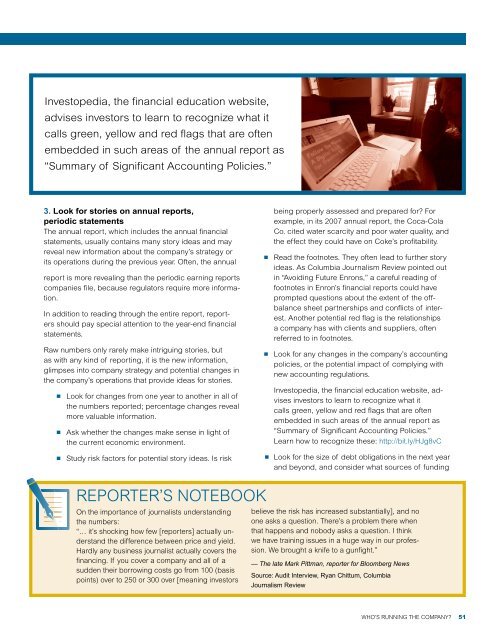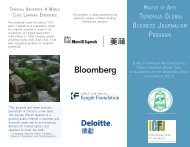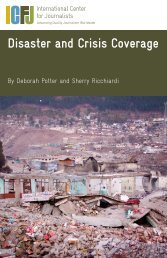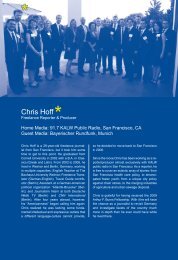Who's Running the Company? - International Center for Journalists
Who's Running the Company? - International Center for Journalists
Who's Running the Company? - International Center for Journalists
You also want an ePaper? Increase the reach of your titles
YUMPU automatically turns print PDFs into web optimized ePapers that Google loves.
Investopedia, <strong>the</strong> financial education website,<br />
advises investors to learn to recognize what it<br />
calls green, yellow and red flags that are often<br />
embedded in such areas of <strong>the</strong> annual report as<br />
“Summary of Significant Accounting Policies.”<br />
3. Look <strong>for</strong> stories on annual reports,<br />
periodic statements<br />
The annual report, which includes <strong>the</strong> annual financial<br />
statements, usually contains many story ideas and may<br />
reveal new in<strong>for</strong>mation about <strong>the</strong> company’s strategy or<br />
its operations during <strong>the</strong> previous year. Often, <strong>the</strong> annual<br />
report is more revealing than <strong>the</strong> periodic earning reports<br />
companies file, because regulators require more in<strong>for</strong>mation.<br />
In addition to reading through <strong>the</strong> entire report, reporters<br />
should pay special attention to <strong>the</strong> year-end financial<br />
statements.<br />
Raw numbers only rarely make intriguing stories, but<br />
as with any kind of reporting, it is <strong>the</strong> new in<strong>for</strong>mation,<br />
glimpses into company strategy and potential changes in<br />
<strong>the</strong> company’s operations that provide ideas <strong>for</strong> stories.<br />
n Look <strong>for</strong> changes from one year to ano<strong>the</strong>r in all of<br />
<strong>the</strong> numbers reported; percentage changes reveal<br />
more valuable in<strong>for</strong>mation.<br />
n Ask whe<strong>the</strong>r <strong>the</strong> changes make sense in light of<br />
<strong>the</strong> current economic environment.<br />
n Study risk factors <strong>for</strong> potential story ideas. Is risk<br />
being properly assessed and prepared <strong>for</strong>? For<br />
example, in its 2007 annual report, <strong>the</strong> Coca-Cola<br />
Co. cited water scarcity and poor water quality, and<br />
<strong>the</strong> effect <strong>the</strong>y could have on Coke’s profitability.<br />
n Read <strong>the</strong> footnotes. They often lead to fur<strong>the</strong>r story<br />
ideas. As Columbia Journalism Review pointed out<br />
in “Avoiding Future Enrons,” a careful reading of<br />
footnotes in Enron’s financial reports could have<br />
prompted questions about <strong>the</strong> extent of <strong>the</strong> offbalance<br />
sheet partnerships and conflicts of interest.<br />
Ano<strong>the</strong>r potential red flag is <strong>the</strong> relationships<br />
a company has with clients and suppliers, often<br />
referred to in footnotes.<br />
n Look <strong>for</strong> any changes in <strong>the</strong> company’s accounting<br />
policies, or <strong>the</strong> potential impact of complying with<br />
new accounting regulations.<br />
Investopedia, <strong>the</strong> financial education website, advises<br />
investors to learn to recognize what it<br />
calls green, yellow and red flags that are often<br />
embedded in such areas of <strong>the</strong> annual report as<br />
“Summary of Significant Accounting Policies.”<br />
Learn how to recognize <strong>the</strong>se: http://bit.ly/HJg8vC<br />
n Look <strong>for</strong> <strong>the</strong> size of debt obligations in <strong>the</strong> next year<br />
and beyond, and consider what sources of funding<br />
REPORTER’S NOTEBOOK<br />
On <strong>the</strong> importance of journalists understanding<br />
<strong>the</strong> numbers:<br />
“… it’s shocking how few [reporters] actually understand<br />
<strong>the</strong> difference between price and yield.<br />
Hardly any business journalist actually covers <strong>the</strong><br />
financing. If you cover a company and all of a<br />
sudden <strong>the</strong>ir borrowing costs go from 100 (basis<br />
points) over to 250 or 300 over [meaning investors<br />
believe <strong>the</strong> risk has increased substantially], and no<br />
one asks a question. There’s a problem <strong>the</strong>re when<br />
that happens and nobody asks a question. I think<br />
we have training issues in a huge way in our profession.<br />
We brought a knife to a gunfight.”<br />
— The late Mark Pittman, reporter <strong>for</strong> Bloomberg News<br />
Source: Audit Interview, Ryan Chittum, Columbia<br />
Journalism Review<br />
WHO’S RUNNING THE COMPANY?<br />
51
















